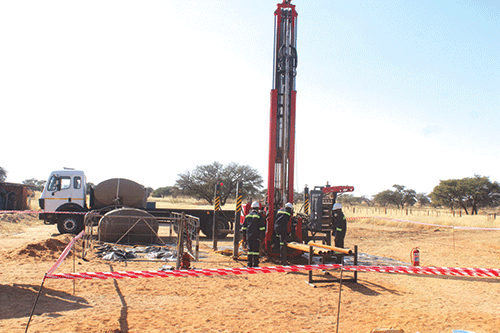The Stampriet Aquifer Uranium Mining Committee, representing the interests of inhabitants of south-east Namibia in the Omaheke region, are concerned proposed uranium extraction methods could potentially harm an aquifer that supplies the only fresh drinking water in the area. However, Uranium One, the Russian parent company of a subsidiary exploring in the area, is adamant the planned uranium mining poses no threat to the underground water resource.
The Stampriet Aquifer Uranium Mining Committee, under the tutelage of chairperson Divan Oppermann, last week warned that the future of all inhabitants of the Stampriet Artesian Basin is in jeopardy. This, he stated, is because mining operations could poison the freshwater source within these more than 63 000 square kilometres.
Oppermann added that the company is sugar-coating the dangers of radioactivity.
“Since in-situ leaching happens underground, no one can see the impact of this process immediately if leakage occurs. There is no guarantee that in-situ leach mining of uranium will not negatively affect our precious drinking water. We do not want to risk the health and safety of our children and of present and future generations, and endanger this unique and critical water resource,” he said in a statement released last week.
In the statement, members of the Stampriet Aquifer Uranium Mining Committee (SAUM) expressed fears that the groundwater could be polluted by uranium, radioactive decay products of uranium, and heavy metals if in-situ leaching is to be utilised. This extraction method has been proposed for two uranium ore bodies, with associated heavy metals discovered in the main and strongest artesian aquifer. According to SAUM, this aquifer contains top-quality drinking water.
SAUM is a committee of concerned farmers, geologists, lodge owners and other stakeholders in the area who are against the ongoing exploration and planned mining.
According to Oppermann, SAUM supports local improvement, development and mining projects if not detrimental to the country.
“Contributions to Namibian communities are always welcome, but window-dressing hides the long-term health dangers that underground, in-situ leach mining of uranium with sulphuric acid in these top-quality drinking water aquifers of the water-controlled Stampriet Artesian Basin presents,” read the statement.
So far, about 600 exploration boreholes for uranium have been drilled in the basin.
SAUM noted that the aquifer water is also pumped by NamWater to supply the communities of Leonardville, Aranos, Aminius, Onderombapa, Derm, Stampriet, Gochas and Koes with drinking water.
Mining response
The Russian company exploring for and hoping to extract uranium in the Omaheke region is Headspring Investments. Headspring Investments is a subsidiary of Uranium One, which falls under Russian state-owned Rusatom. This is Russia’s Stated Atomic Energy Corporation specialising in nuclear energy and is also a uranium exploration, mining and processing company.
Headspring Investments has proposed the in-situ leaching (ISL) method to extract uranium in Namibia. ISL, also called in-situ recovery (ISR) or solution mining, is a mining process used to recover minerals such as copper and uranium through boreholes drilled into a deposit.
Responding to questions from New Era, Uranium One spokesperson Riaan van Rooyen said in-situ recovery technology has been in use for over 50 years, and is an accepted method used in Russia, Kazakhstan, Uzbekistan, the USA and Australia.
“The sulphuric acid is used as a weak solution (only 1% to 5%). This weak solution poses no danger to the underground water resource,” he stated.
Van Rooyen added that the proposed extraction method also constantly monitors boreholes to confirm the composition of underground water.
“These monitoring boreholes are not only placed in the aquifer where the uranium is extracted from, but also in all other aquifers. Through the teachings that have been gathered over the last 50 to 60 years, there are enough checks and balances that will ensure safe mining,” he said. Uranium One is also in consultations with the agriculture ministry regarding the commencement of field operations.
Familiarisation tour
Last week, the Russian mining company conducted a familiarisation tour at Farm Tripoli in the Leonardville area in south-eastern Namibia, where the exploration is being conducted. However, SAUM believes they should have been invited to share their concerns.
Despite this, Van Rooyen emphasised that the company has nothing to hide, and will not benefit by not engaging all key stakeholders. There is, therefore, a scheduled meeting with the committee.
Upon the commencement of mining operations, Uranium One could invest between US$300 million to US$500 million in the domestic economy over 25 years.
And, according to the company’s project manager Kirill Egorov, Uranium One has already invested about US$50 million in the domestic economy. He also stressed that the company’s mining methods are environmentally-friendly.
Also during the familiarisation tour, the project was welcomed by government when both mines’ deputy minister Kornelia Shilunga and Omaheke governor Pijoo Nganate stated that such projects are of great importance to the community as they bring much-needed development.


